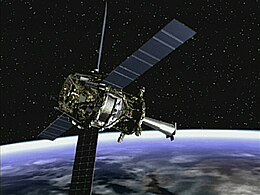
Back مسبار الجاذبية B Arabic Gravity Probe B Catalan Gravity Probe German Gravity Probe B Spanish Gravity Probe B Estonian حسگر گرانش بی Persian Gravity Probe B Finnish Gravity Probe B French Gravity Probe B Galician בדיקת כוח הכבידה II HE
 | |
| Mission type | Astrophysics |
|---|---|
| Operator | NASA/Stanford University |
| COSPAR ID | 2004-014A |
| SATCAT no. | 28230 |
| Website | einstein |
| Mission duration | 6 years, 7 months and 17 days [1] |
| Spacecraft properties | |
| Manufacturer | Lockheed Martin |
| Launch mass | 3,100 kg (6,800 lb)[1] |
| Dimensions | 6.4 m × 2.6 m (21.0 ft × 8.5 ft)[1] |
| Power | 606 W Spacecraft: 293 W Payload: 313 W[1] |
| Start of mission | |
| Launch date | 20 April 2004, 16:57:24 UTC |
| Rocket | Delta II 7920-10C |
| Launch site | Vandenberg SLC-2W |
| End of mission | |
| Disposal | Decommissioned |
| Deactivated | 8 December 2010 |
| Orbital parameters | |
| Reference system | Geocentric |
| Regime | Low Earth |
| Semi-major axis | 7,027.4 km (4,366.6 mi) |
| Eccentricity | 0.0014[1] |
| Perigee altitude | 641 km (398 mi)[2] |
| Apogee altitude | 645 km (401 mi)[2] |
| Inclination | 90.007º[1] |
| Period | 97.65 minutes[3] |
| Epoch | UTC[2] |

| |
Gravity Probe B (GP-B) was a satellite-based experiment to test two unverified predictions of general relativity: the geodetic effect and frame-dragging. This was to be accomplished by measuring, very precisely, tiny changes in the direction of spin of four gyroscopes contained in an Earth-orbiting satellite at 650 km (400 mi) of altitude, crossing directly over the poles.
The satellite was launched on 20 April 2004 on a Delta II rocket.[4] The spaceflight phase lasted until ;[5] Its aim was to measure spacetime curvature near Earth, and thereby the stress–energy tensor (which is related to the distribution and the motion of matter in space) in and near Earth. This provided a test of general relativity, gravitomagnetism and related models. The principal investigator was Francis Everitt.
Initial results confirmed the expected geodetic effect to an accuracy of about 1%. The expected frame-dragging effect was similar in magnitude to the current noise level (the noise being dominated by initially unmodeled effects due to nonuniform coatings on the gyroscopes). Work continued to model and account for these sources of error, thus permitting extraction of the frame-dragging signal. By , the frame-dragging effect had been confirmed to within 15% of the expected result,[6] and the NASA report indicated that the geodetic effect was confirmed to be better than 0.5%.[7]
In an article published in the journal Physical Review Letters in , the authors reported analysis of the data from all four gyroscopes results in a geodetic drift rate of −6601.8±18.3 mas/yr and a frame-dragging drift rate of −37.2±7.2 mas/yr, in good agreement with the general relativity predictions of −6606.1±0.28% mas/yr and −39.2±0.19% mas/yr, respectively.[8]
- ^ a b c d e f "Gravity Probe B" (PDF). NASA Facts. NASA and Stanford University. February 2005. Retrieved 17 March 2011.
- ^ a b c "Spacecraft orbit: Gravity Probe B". National Space Science Data Center. 2004. Retrieved 18 January 2015.
- ^ G. Hanuschak; H. Small; D. DeBra; K. Galal; A. Ndili; P. Shestople. "Gravity Probe B GPS Orbit Determination with Verification by Satellite Laser Ranging" (PDF). Retrieved 17 March 2011.
- ^ "Frequently asked Questions". Gravity Probe B. Stanford University. Answers to Spacecraft and Mission Operations Questions: 1. When and where was GP-B launched, and where can I find photos, video or news clips of the launch?. Retrieved 14 May 2009.
- ^ "Frequently asked Questions". Gravity Probe B. Stanford University. Answers to Spacecraft and Mission Operations Questions: 4. Where is the GP-B Mission Operations Center (MOC) for controlling the spacecraft in orbit?. Retrieved 14 May 2009.
- ^ Gugliotta, G. (16 February 2009). "Perseverance Is Paying Off for a Test of Relativity in Space". The New York Times. Retrieved 18 February 2009.
- ^ Everitt, C.W.F.; Parkinson, B.W. (2009). "Gravity Probe B Science Results—NASA Final Report" (PDF). Retrieved 2 May 2009.
- ^ Cite error: The named reference
PRLwas invoked but never defined (see the help page).
© MMXXIII Rich X Search. We shall prevail. All rights reserved. Rich X Search